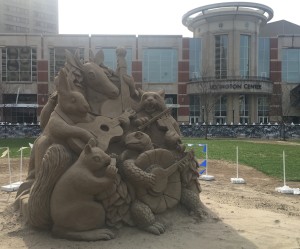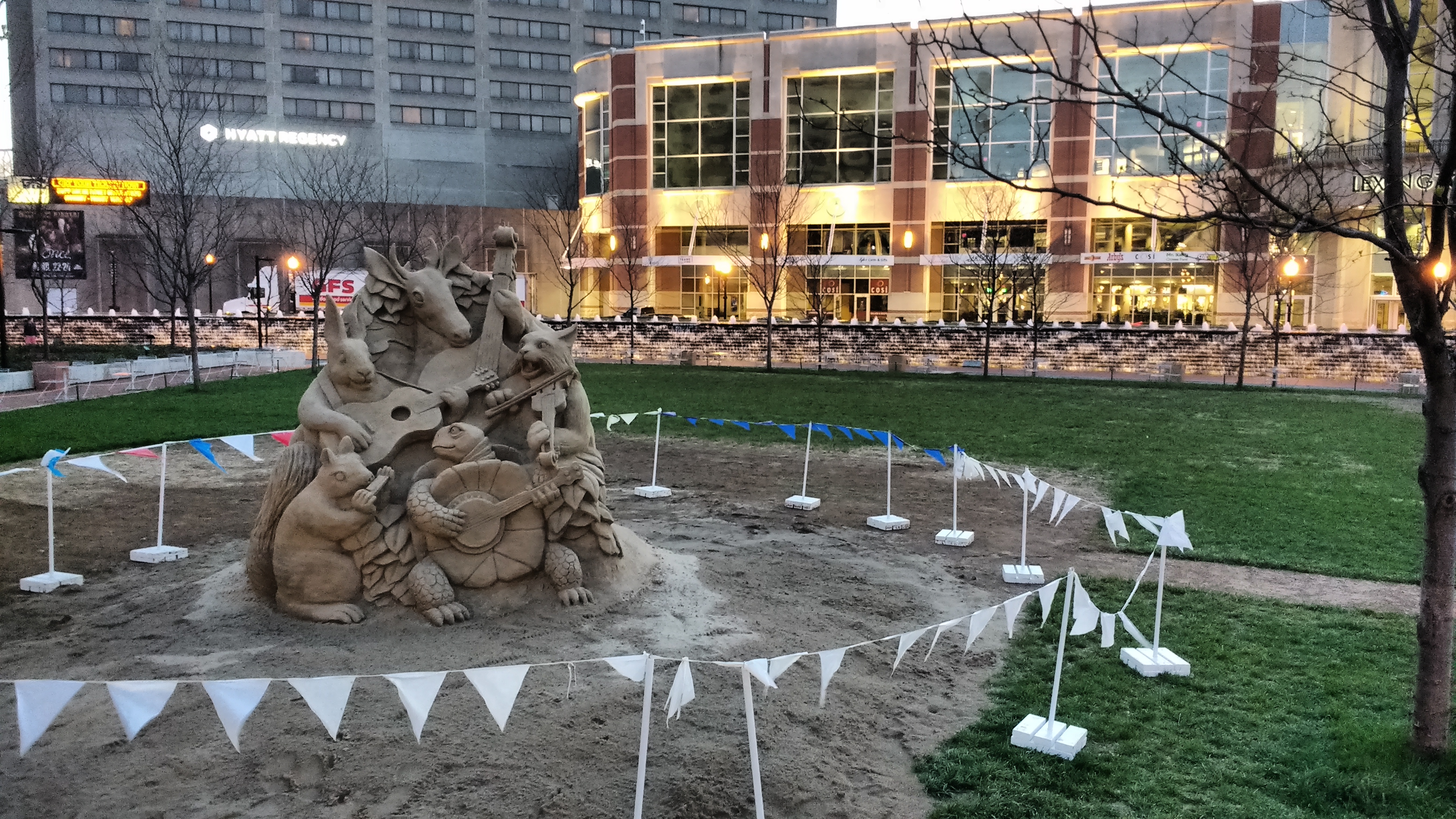Sand sculpture finds temporary home at Triangle Park: Damon Farmer from Woodford County carved a Kentucky-themed sand sculpture
by Aayat Ali


The 21-ton sand sculpture pays homage to all things Bluegrass and Kentucky. It features a squirrel playing harmonica, a rabbit on guitar, a turtle playing banjo, a deer with a stand-up bass and a traditional Kentucky wildcat on fiddle.
Shadetree Studio
Damon Farmer from Versailles has over 30 years of sand sculpting experience under his belt, but is also an internationally recognized, award-winning artist on many mediums.
Among Farmer’s many talents, he holds the titles of World Champion, American Champion, and North American Sand Sculpting Champion several times. He created the Shadetree Studio by himself in 1978.
“I started doing sand sculpting in 1975. It was my first trip I made to the beach as an adult. I had gone south to paint because it was winter in Kentucky and I ended up doing more sand sculpting than painting. Just discovered it as a medium and really liked it. It was a vacation hobby for years,” said Farmer. “Since about 1990, I have been doing it for income.”
Farmer has participated in sand sculpting competitions all over the world, including in China, Puerto Rico, Japan, Mexico, and all over the U.S.
“Sand in the City”
The temporary art display is a part of the Downtown Lexington Corporation’s project “Sand in the City.” The Bluegrass Sotheby’s International Realty and Hilliard Lyons, a wealth management firm, funded the project. The corporation allowed the public to submit idea entries for the sculpture earlier this month, and Farmer picked from the selected few.


The sculpture took four days to complete.
The Process
The process begins with sketching out the art and choosing a site near a water hose connection, because dry sand is prone to falling apart.
“When I’m working for a client, I show them a sketch for what I have in mind. Sometimes they have their own input, like in this case,” said Farmer. “As far as using that as a guide to sculpt with, once I have it memorized and know what it looks like, I don’t pay too much attention to the sketch… It evolves as it goes.”
He had help from Big Blue Bobcat Services that provided a bobcat operator to move the sand on preparation day as well as the R.W. Thompson Landscaping Company to help him shovel.
He first builds a wooden frame and a layer of sand is poured into the middle. From here, water is added to the sand and condensed together with a jumping jack compactor so the “grains are closer together.” Each of these steps is repeated until a solid stepping platform is created.
“We’re generating a big carving block. Once the wood is removed, the sand is carved from the block to uncover the sculpture inside it,” said Farmer.
The inside of the sculpture is comprised only of water and sand. He said that the sculpture by itself is very durable, but once the art is totally complete, he sprays it with clear Elmer’s glue. The glue creates a thin crust to protect the art from wind and rain damage.
“20-tons is the amount of sand a truck can haul. I know that in 20-tons I can carve something fully in four days’ time, but there are always long days. Every day I think was about ten hours. We spent one whole day packing it all up.”
Farmer’s Fulfillment
Although Damon Farmer is an internationally recognized artist, he said that being able to commute to his work for this project was especially nice.
“It was very nice to work at home. I so often travel overseas and across the country to do these projects. I love the work and enjoy it, but it’s staying in motels and being away from home.”
Social media blew up with responses to “Animals of the Bluegrass.” Since many people hardly ever see sand sculptures, Farmer said the most fulfilling part of this project for him was the public response.
“The public was so complimentary and gracious and appreciative,” said Farmer. “Sand sculptures, of course, are temporary, but it compares to a symphony. You’re hearing it in the moment and it’s for the people who witness it while it lasts, and then it’s gone…sand is the same way.”
Subscribe to the Ace e-dition for Lexington news, arts, culture, and entertainment, delivered to your inbox every Thursday morning.










